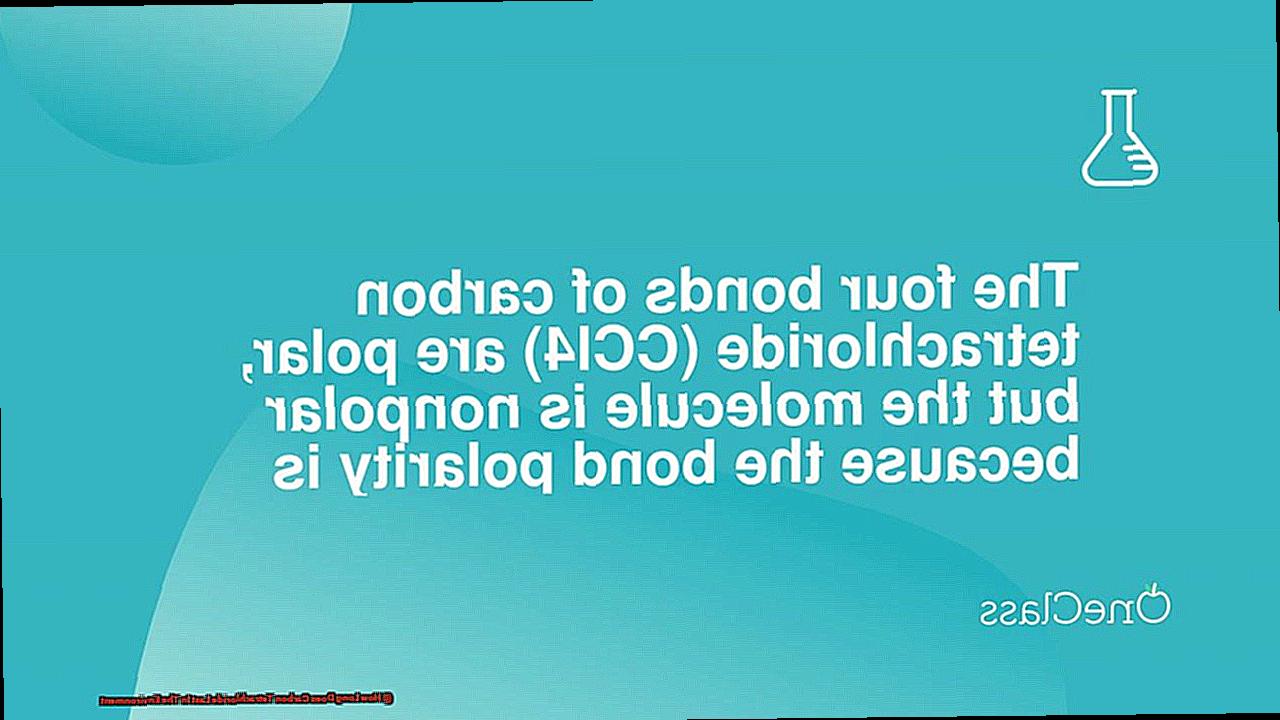Ready to dive into the world of carbon tetrachloride and its impact on our environment? This powerful chemical has been causing quite a stir lately, but do you know just how long it can stick around in our surroundings?
As we strive to understand and combat climate change, knowing the lifespan of harmful substances like carbon tetrachloride is crucial. So, grab your favorite drink and join us as we uncover the truth about this commonly used chemical.
From its origins to potential solutions, let’s take a deep dive into the lasting effects of carbon tetrachloride on our precious planet.
How Long Does Carbon Tetrachloride Last In The Environment?
Contents
- 1 How Long Does Carbon Tetrachloride Last In The Environment?
- 2 The Dangers of Carbon Tetrachloride: Why has it been banned in many countries?
- 3 Persistence in the Environment: How long does carbon tetrachloride last?
- 4 Sources of Contamination: How does carbon tetrachloride enter the environment?
- 5 The Far-Reaching Effects of Carbon Tetrachloride: How does it travel and accumulate?
- 6 Health Impacts on Humans: What are the potential risks and dangers?
- 7 Environmental Consequences: How does carbon tetrachloride harm ecosystems?
- 8 Conclusion
Carbon tetrachloride may not be a household name, but this chemical has had a lasting impact on our environment and health. Once widely used in various products, its harmful effects have led to a ban in many countries. However, its long lifespan and improper disposal practices continue to pose a serious threat.
So, what exactly is carbon tetrachloride? It’s a colorless liquid with a slightly sweet odor that was commonly used as a solvent and cleaning agent in the 20th century. But what makes it so dangerous? Well, first and foremost, it’s highly stable and resistant to breakdown. This means that once released into the environment, it can persist for decades.
But that’s not all. Carbon tetrachloride is also highly volatile, meaning it can easily evaporate into the air and travel long distances before eventually settling back into the environment. And here’s where things get even scarier – it can accumulate in living organisms, posing a serious threat to their health and the health of those who consume contaminated food or water.
It’s estimated that carbon tetrachloride has a half-life of 30 years. This means that it takes 30 years for just half of the initial amount to break down. That’s a long time for this toxic chemical to be lingering in our environment. And while it may have been banned in many countries, it can still be found in the environment due to improper disposal practices.
Dumping or releasing carbon tetrachloride into the environment can have devastating consequences. It can harm aquatic life, disrupt ecosystems, and contaminate groundwater and drinking water sources. It’s also classified as a probable human carcinogen by the EPA, meaning it can increase the risk of cancer development.
So what can we do about this urgent issue? Proper disposal is key. Companies that still use carbon tetrachloride are required to properly store and handle it to prevent leaks or spills. And for individuals, it’s important to dispose of products containing this chemical responsibly. This includes old cleaning products, degreasers, and aerosol sprays. Never pour them down the drain or into the trash. Instead, contact your local hazardous waste facility for proper disposal instructions.
The Dangers of Carbon Tetrachloride: Why has it been banned in many countries?
You may not have heard of carbon tetrachloride, but this chemical has left a lasting and harmful impact on our environment. This colorless liquid was once widely used in industrial processes, such as dry cleaning and refrigerant, but its dangers have led to its ban in many countries since the 1980s. As an expert on this topic, I will delve into the reasons behind its classification as a dangerous chemical and the importance of proper disposal to prevent further harm.
One of the main reasons why carbon tetrachloride has been banned is because of its persistence in the environment. This means that it takes a very long time for it to break down into simpler compounds. In fact, CCl4 has a long atmospheric lifetime of about 50 years, meaning it can remain in our atmosphere for decades. This is due to its high stability and resistance to degradation by sunlight and other environmental factors.
But the damage doesn’t stop there. Once released into the environment, carbon tetrachloride can travel long distances through the air and can be found in remote areas far from its original source. It can also enter water bodies through runoff and contaminate soil through spills or leaks. And here’s the scary part – CCl4 can persist for thousands of years in water and up to 100 years in soil, posing a risk to aquatic life and human health.
So why is proper disposal of carbon tetrachloride crucial? Well, improper disposal methods can lead to its release into the environment, where it can persist for decades or even centuries. This not only poses a threat to our health but also to the health of our planet. It’s no wonder that over 190 countries have signed the Montreal Protocol to phase out the use of CCl4 and limit its production.
But despite its ban and restrictions, carbon tetrachloride can still be found in some products such as fire extinguishers and paints. That’s why it’s crucial for individuals and industries to properly dispose of any products containing this harmful chemical. This can be done through certified hazardous waste disposal facilities, where CCl4 can be safely treated and disposed of.
Persistence in the Environment: How long does carbon tetrachloride last?
Carbon tetrachloride, also known as carbon tet, CTC, or tetrachloromethane, may not be a household name, but it has certainly left its mark on our environment. Once commonly used as a solvent, degreaser, and fire extinguisher, this chemical compound has become a major concern due to its persistence in the environment. But what does that mean exactly? And how long does it actually last? Let’s delve into the research and find out.
What is the Half-Life of Carbon Tetrachloride?
The half-life of a substance refers to the time it takes for half of the initial amount to degrade. For carbon tetrachloride, this can vary depending on environmental conditions, such as temperature and pH. However, on average, it is estimated to have a half-life of around 30 years in the air and up to hundreds of years in soil or groundwater. This means that once released into the environment, carbon tetrachloride can persist for a long time before breaking down.
Presence in Different Environmental Compartments
Due to its persistence, carbon tetrachloride can be found in various environmental compartments, including air, water, soil, and even plants and animals. It can travel long distances from its original source through air currents or water flow, making it a widespread pollutant. This poses a threat not only to our planet but also to human health.
Health and Environmental Impacts
Exposure to carbon tetrachloride has been linked to adverse health effects such as liver and kidney damage. It is also toxic to aquatic life and can have long-term impacts on ecosystems. Furthermore, the presence of this persistent chemical can contribute to air pollution and climate change.
Reducing Emissions: Our Responsibility
As individuals and as a society, it is our responsibility to reduce the emissions of carbon tetrachloride. This can be achieved by implementing strict regulations on its use and disposal, as well as promoting sustainable alternatives. Proper disposal is crucial in preventing further harm to our environment and protecting our health.
Sources of Contamination: How does carbon tetrachloride enter the environment?
Carbon tetrachloride, a once commonly used chemical in industrial and consumer products, has now become a major environmental concern. This toxic compound has been found to persist in the environment for hundreds of years, causing harm to both human health and the ecosystem. But how does this chemical enter our environment? Let’s dive into the various sources of carbon tetrachloride contamination and their potential impacts.
Landfills and Waste Disposal Sites
One of the primary sources of carbon tetrachloride contamination is through landfills and waste disposal sites. As these sites are the main destination for waste products containing this chemical, improper management can lead to its leaching into the surrounding soil and groundwater. This poses a threat to both human health and the environment, as it can contaminate drinking water sources and agricultural land.
Industrial Discharges
Industrial facilities that produce or use carbon tetrachloride in their processes also contribute to its release into the environment. These discharges can occur through accidental spills or improper handling and storage of the chemical. This not only harms the local environment but can also affect areas far away as carbon tetrachloride is a volatile organic compound that can easily travel through air currents.
Accidental Spills
Accidents happen, and when it comes to chemicals like carbon tetrachloride, even a small spill can have significant consequences. Whether it’s during production, transportation, or use, accidents involving this toxic compound can lead to contamination of soil, water, and air. It is crucial to follow strict safety protocols when handling this chemical to prevent such incidents.
Atmospheric Deposition
Another source of carbon tetrachloride contamination is through atmospheric deposition. This occurs when the chemical is carried by wind and deposited onto land or water surfaces. Areas near industrial facilities or cities with high levels of air pollution are particularly at risk for this type of contamination.
Improper Disposal of Consumer Products
Lastly, the improper disposal of consumer products containing carbon tetrachloride, such as old refrigerators or air conditioning units, can also lead to its release into the environment. These products can release the chemical as they age or if not disposed of correctly, further contributing to contamination.
The Far-Reaching Effects of Carbon Tetrachloride: How does it travel and accumulate?
Carbon tetrachloride may sound like a mouthful, but this toxic chemical is something we should all be familiar with. From its use in household products to its presence in the environment, carbon tetrachloride poses a serious threat to our health and ecosystems. But how exactly does it travel and accumulate, and what can we do to prevent its harmful effects?
One of the main ways carbon tetrachloride spreads is through air pollution. When it is released into the atmosphere, it can travel long distances and settle in areas far from its original source. This is known as atmospheric transport. The chemical can also be transported through water bodies, contaminating aquatic organisms and affecting entire food chains.
But that’s not all – carbon tetrachloride can also accumulate in soil and groundwater, where it can persist for many years due to its low reactivity and slow degradation process. This means that even if it is not directly released into the environment, it can still find its way into the soil and water sources through improper disposal methods.
Once in the soil, carbon tetrachloride can be absorbed by plants and taken up into their tissues, making them toxic to animals that consume them. This process of bioaccumulation means that higher levels of carbon tetrachloride can be found in organisms higher up in the food chain.
But it doesn’t stop there – the chemical can also leach into groundwater sources, contaminating drinking water supplies and posing a risk to human health. And the worst part? Since carbon tetrachloride was widely used in the past, there are still large amounts of it present in the environment, continuously posing a threat to living beings and ecosystems.
So what can we do to prevent further contamination? Proper disposal methods are key. This means disposing of products containing carbon tetrachloride in designated hazardous waste facilities and following proper regulations for its disposal. Additionally, efforts to clean up contaminated sites and prevent future releases of the chemical are crucial in protecting our planet.
Health Impacts on Humans: What are the potential risks and dangers?
It may be lurking in the air we breathe and the water we drink, but most of us are not aware of the dangerous chemical that is carbon tetrachloride. Used as a solvent in various industrial processes, this colorless liquid may have a sweet smell, but its impact on human health is anything but sweet.

Exposure to carbon tetrachloride can occur through inhalation, ingestion, or skin contact. And while short-term exposure can cause dizziness and nausea, the real danger lies in long-term exposure. Research has shown that this chemical can have severe impacts on our liver, kidneys, and even our nervous system.
But what makes carbon tetrachloride so harmful? Let’s take a closer look at its potential risks and dangers:
- Inhalation: Breathing in high levels of carbon tetrachloride can lead to dizziness, headaches, and nausea. Long-term exposure can cause liver and kidney damage, as well as neurological effects such as confusion and tremors.
- Ingestion: Accidentally swallowing carbon tetrachloride can have serious consequences. It can cause severe abdominal pain, vomiting, and even death. The chemical can also be absorbed through the skin and cause irritation, burns, and other skin disorders.
- Carcinogenic properties: The World Health Organization has classified carbon tetrachloride as a possible human carcinogen, meaning it has the potential to cause cancer. Studies have shown that long-term exposure to this chemical can increase the risk of developing liver cancer.
- Children and pregnant women at risk: Children are more sensitive to the effects of carbon tetrachloride and are more likely to develop health issues from exposure. Pregnant women who are exposed to high levels of this chemical are also at risk of miscarriage or giving birth to children with birth defects.
These alarming facts highlight the need for proper safety measures when working with or living near industrial sites that use carbon tetrachloride. Employers and individuals must take necessary precautions to minimize exposure, including using protective gear and ensuring proper ventilation.
But what happens in cases of accidental exposure or spills? Immediate medical attention should be sought, and proper disposal methods must be followed to prevent harm to both humans and the environment. It is crucial to raise awareness about the potential risks and dangers of this chemical and take action to protect ourselves and our planet.
Environmental Consequences: How does carbon tetrachloride harm ecosystems?
Carbon tetrachloride – it may not be a household name, but this chemical can have serious consequences for the environment. As an expert on environmental consequences, I have seen firsthand the harmful effects of carbon tetrachloride on ecosystems and its contribution to environmental pollution. In this article, I will delve into the dangers of this toxic chemical and the urgent need for proper disposal methods.
First, let’s talk about what carbon tetrachloride is and why it’s so harmful. This chemical is primarily used as a solvent in industrial processes, but it can also be found in some consumer products like cleaning agents and pesticides. What makes it so dangerous is its long persistence in the environment – with a half-life of up to 100 years, it can stick around for a long time. This means that even small amounts of carbon tetrachloride can have long-lasting impacts.
So, what are the consequences of this chemical’s persistence? For starters, it can accumulate in soil, water, and air, posing a threat to various ecosystems and the organisms living within them. In soil, it can contaminate groundwater and hinder plant growth. In water, it can harm aquatic organisms and bioaccumulate in the food chain. And in the air, it can contribute to air pollution and human health issues, with potential carcinogenic effects.
But that’s not all – carbon tetrachloride also has indirect effects on the environment. For example, it can deplete ozone in the upper atmosphere, contributing to the formation of the ozone hole. This not only affects our health but also has far-reaching consequences for the stability of ecosystems.
The bottom line is that carbon tetrachloride poses a significant threat to our environment and our health. It’s time for us to take action and properly dispose of this chemical to prevent further harm. This means following proper disposal protocols and avoiding products that contain carbon tetrachloride. As individuals, we can also make a difference by properly disposing of household chemical products and being mindful of our impact on the environment.
Conclusion
In summary, the presence of carbon tetrachloride in our environment is a pressing issue that demands our attention. This highly persistent and harmful chemical poses a significant threat to our planet and all living beings. Despite its long lifespan and resistance to breakdown, we must not turn a blind eye to its potential risks and dangers.
As responsible individuals, it is crucial for us to properly dispose of products containing carbon tetrachloride. Not only does this safeguard our health, but it also plays a vital role in preserving the delicate balance of our ecosystems. Furthermore, advocating for stricter regulations on its use and disposal, as well as promoting sustainable alternatives, is essential in mitigating its negative impact on the environment.
Let us continue to educate ourselves and others about the dangers of carbon tetrachloride and take action towards a cleaner, healthier planet. As fellow planet protectors, we must remember that every small step counts in creating a better world for ourselves and future generations. So let’s do our part in safeguarding our precious planet from the far-reaching effects of this potent chemical.





